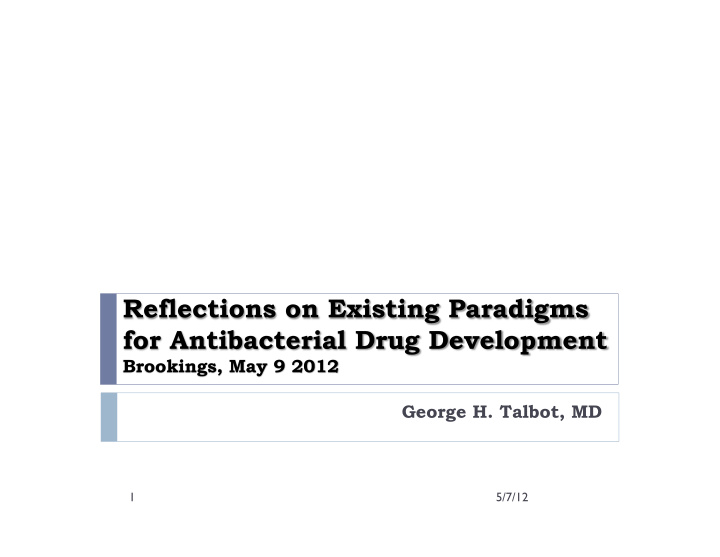



George H. Talbot, MD 1 5/7/12
Within the past 36 months: Board compensation and/or consultancy fees from Actelion, Basilea, Cempra, Cerexa, Durata, Cubist-Calixa, Fab Pharma, J&J, Kalidex, Meiji, Merada, Merck, Nabriva, Wyeth/Pfizer (DSMB). Equity: Durata, Calixa, Cerexa, Kalidex, Nabriva Member, IDSA Antimicrobial Availability Task Force Co-Chair FNIH Project Team, Addressing Endpoints for Clinical Trials of Drugs for the Treatment of CABP and ABSSSI Today: Representing Talbot Advisors LLC 2 5/7/12
The influence of regulatory science on antibacterial drug development The role of – and our responsibility to - NI trial designs in antibacterial drug development Most pressing unmet clinical needs Where Guidance is needed Activities to support antibacterial drug development 3 5/7/12
Regulatory Science should always be in evolution Science advances…..Stasis can be detrimental Evolution occurs in fits and starts… incrementally Periods of rapid evolution bring uncertainty and are stressful Ideally, evolutionary dead ends may occur, but this should be outweighed by many more opportunities for progress Evolution should be encouraged, but not at the cost of paralysis in new drug development Goal: pragmatic solutions that facilitate approval of safe and efficacious new drugs… due to, or despite, evolution in regulatory science Evolution should be managed to result in a “Win-Win” for all stakeholders: Patients, physicians, industry and regulators 4 5/7/12
Regulatory decisions should be communicated broadly and in a timely, transparent manner Stakeholders should be open-minded until success or failure of new approaches can be judged based on accruing evidence Selection of the appropriate fora for discussion is critical Global harmonization essential Inclusive of varying viewpoints All stakeholder groups represented Non-politicized Opportunity for continuing, iterative interactions Ability to compromise when necessary to move forward 5 5/7/12
Drafting and issuing Guidance Documents has been laborious and time-consuming for FDA Workshops and advisory committees appear to have often been an inefficient way to obtain the expert input on which FDA can then base new Guidances Delay, uncertainty…no New Drugs despite more Bad Bugs New models needed to ensure timely progress on issues of regulatory science and to avoid stasis Brookings Institute FNIH Transparent interactions with other regulators Other? 6 5/7/12
The bread and butter of antibacterial drug development Won’t change…shouldn’t except in specific situations Hypotheses should be informed in a “Bayesian” manner by robust, highly predictive preclinical data But, we shouldn’t pick and choose which preclinical data sets to accept based on purely pragmatic considerations Example: prior antibiotic therapy, which could affect baseline bacterial burden and therefore confound assessment of treatment effect If we want to use NI trial design, we must conform to the requisite principles, and/or provide an opportunity for data accrual during future registrational studies Example: major abscess in ABSSSI We can’t have our cake and eat it too 7 5/7/12
Approval pathways for (currently) uncommon, emerging MDR pathogens Hospital-acquired Bacterial Pneumonia/ Ventilator- Associated Pneumonia Evidence-based Guidance for allowable use (or not) of prior antibiotics Integration of rapid diagnostics into clinical trial design to enrich study populations and avoid dilution in NI trials 8 5/7/12
Potential Future Activities to Support Antibacterial Drug Development Rapid issuance of new/ revised Guidances CABP ABSSSI cIAI MDR pathogens External review of Guidances that address Pressing Unmet Clinical Needs MDR pathogen development pathways HABP/VABP development Approach to prior antibacterial therapy in NI trials 9 5/7/12
Thank you 10 5/7/12
Recommend
More recommend